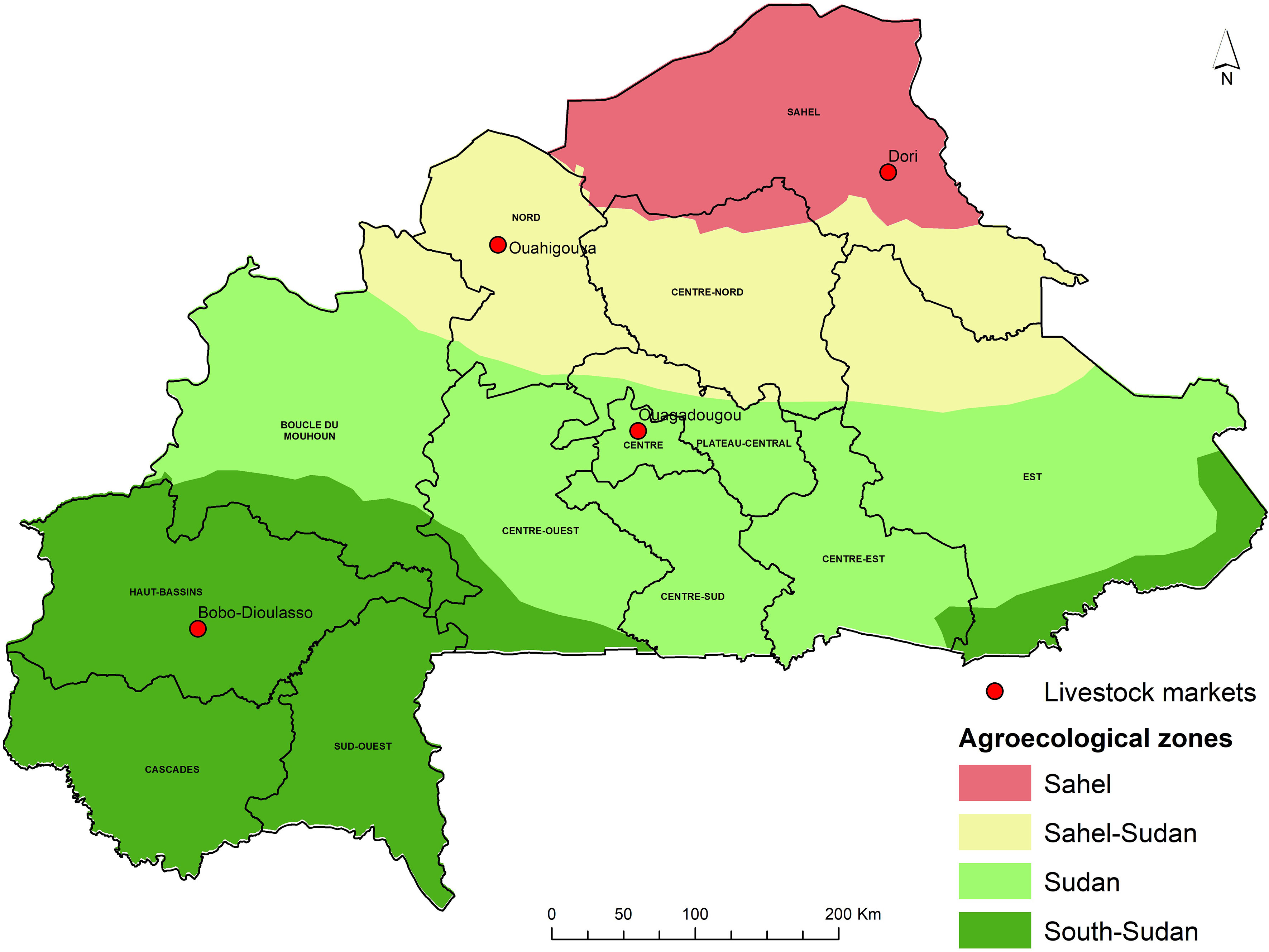- 1International Livestock Research Institute (ILRI), Dakar, Senegal
- 2International Livestock Research Institute (ILRI), Ibadan, Nigeria
- 3International Livestock Research Institute (ILRI), Addis Ababa, Ethiopia
- 4Global Academy of Agriculture and Food Systems, University of Edinburgh, Edinburgh, Scotland, United Kingdom
Livestock form a major means of livelihood in Burkina Faso where almost 80% of the rural population keep sheep and goats. However, the major constraint to livestock productivity is seasonal feed scarcity. To bridge the increasing feed gap, particularly in the dry season, livestock keepers are increasingly turning to purchase of feeds from markets, which has led to emergence of feed markets in peri-urban towns and cities in the Sahel. To characterize the dynamics of these livestock feed markets, to inform and guide the development of efficient feeding systems in peri-urban livestock production, we conducted surveys in feed markets in four major towns and cities of Burkina Faso across all the agro-ecological zones. Results from this study showed that the feed types on sale included browse, bush hay, bran of maize, millet, sorghum, rice and wheat, legume residues, cereal straw and agro-industrial by-products such as cottonseed cake and concentrate feed for ruminants. The average number of feeds sold per vendor ranged from 1.5 ± 0.1 in early dry season to 3.5 ± 0.4 in late dry season. More than 80% of the feed sellers in each location reported that generation of additional income for the household was the principal reason for feed sale. The price of livestock feeds sold at different locations in Burkina Faso varied significantly with season, market location and feed type. Cottonseed cake had the highest crude protein content in all locations and across seasons ranging from an average of 16.3 to 31.9% while cereal straw (millet, maize and sorghum straw) had the lowest crude protein content of 3.5%. The results also showed a lack of a clear trend in terms of relationship between price and nutritional quality which confirms the absence of quality standardization for feeds on sale in our study sites. In developing feed industry in the region, the issue of quality standardization needs to be addressed to facilitate establishment of nutritive value-based pricing and to ensure that consumers pay a premium for quality products.
1 Introduction
Livestock form a major means of livelihood in Burkina Faso where almost 80% of the rural population keep sheep and goats, as they are key household assets for multiple functions such as food supply, income generation and as a store of wealth and insurance (Ayantunde et al., 2020). The major constraint to livestock productivity in Burkina Faso and other West African Sahelian countries is seasonal scarcity of feed, both in terms of quantity and quality (Ouedraogo et al., 2021; Amole et al., 2022) to varying extents in different agro-ecological zones. Generally, feed biomass including natural pastures and crop residues, is abundant in the South-Sudan agro-ecological zone of Burkina Faso for almost 10 months of the year (Savadogo et al., 1999), which makes the zone a popular destination for transhumant pastoralists from the Sahelian zone (Zampaligré, 2012). The Sahelian zone of Burkina Faso and other neighbouring countries (Mali and Niger) is characterized by feed deficit for livestock for almost for 4 to 7 months of the year (Ayantunde et al., 2011; Amole et al., 2022) as natural pastures are not sufficient to satisfy animal requirements in the dry season when the quantity decreases by 25 to 50% of peak biomass (Savadogo et al., 1999).
The increasing feed gap for livestock in the West African Sahel could be partly attributed to increase in livestock population (Ayantunde et al., 2022). To mitigate the problem of feed scarcity, particularly in the dry season, livestock keepers are increasingly turning to purchase of feeds from markets (Ayantunde et al., 2014). The increasing demand for feeds has contributed to the emergence of livestock feed markets in many peri-urban towns and cities in West African Sahel (Ayantunde et al., 2022). These feed markets are characterized by sale of crop residues, cereal bran, browses, bush hay and agro-industrial by-products. The feed markets are often located close to livestock markets and sometimes along the roads, while agro-industrial by-products are sold at agro-dealer shops (Ayantunde et al., 2022).
In a well-functioning livestock system, feed price varies based on classic supply-demand characteristics. Shortage of overall feed, as may occur during the dry season, leads to higher prices for feed (Ayantunde et al., 2014). Similarly, feeds of higher quality (both within and between feed types) attract higher prices since they support higher levels of livestock production. Previous studies have been able to show that higher quality feeds attract higher price. For example, Blummel and Rao (2006) reported that a difference of 5% units increase (range 47 to 52%) in in vitro Organic Matter Digestibility (IVOMD) of sorghum straw was associated with a higher price of about 25%. In the United States of America, alfalfa hay buyers and sellers often use Relative Feed Value (RFV) index for benchmarking marketing grades of alfalfa hays, which consequently informed the price (Rocateli and Zhang, 2017). Hay with higher value of RFV indicates better nutritional quality and vice versa. Lack of close relationships between price and quality, particularly for crop residues as reported in previous studies on livestock feed markets in West Africa (Wane et al., 2010; Ayantunde et al., 2014; Jarial et al., 2016; Ayantunde et al., 2022) suggest market failures, due to lack of information. In the case of feed, the key information relates to reasonable estimates of feed quality and in the absence of feed standards and their enforcement, buyers may have inadequate information on which to base price decision.
This study aimed at characterizing the livestock feed markets in different agro-ecological zones of Burkina Faso and to collect information on the price and quality of livestock feeds at different markets across seasons. The underlying hypothesis for this study is that feed price varied with agro-ecological zone (market location), season, feed type and provenance. Unlike previous studies on livestock feed market in the Sahel (Wane et al., 2010; Ayantunde et al., 2014; Jarial et al., 2016; Ayantunde et al., 2022) that were mainly conducted in peri-urban areas in one or two agro-ecological zone(s), this study covered all the agro-ecological zones in Burkina Faso and will therefore provide a national outlook of livestock feed price and quality across seasons and can inform policy on feed marketing in the country. In addition, the results of this study have implications beyond Burkina Faso as the agro-ecological gradients in Burkina Faso are typical of other West African Sahelian countries.
2 Materials and methods
2.1 Study sites, feed market surveys and laboratory analysis
Surveys were conducted in livestock feed markets in four peri-urban areas across the four agro-ecological zones (South-Sudan, Sudan, Sahel-Sudan and Sahel) of Burkina Faso (Figure 1) in the late dry season (April – May 2019), wet season (July – August 2019) and early dry season (November-December 2019). The surveys were conducted in Bobo-Dioulasso (commonly referred to as Bobo) in South-Sudan zone, Ouagadougou in Sudan zone, Ouahigouya in Sahel-Sudan zone and Dori in the Sahel zone of Burkina Faso. Five feed markets each were surveyed in Bobo and Ouagadougou, while three markets each were surveyed in Ouahigouya and Dori. In each location, independent feed sellers and buyers were randomly selected and interviewed in their local language by an enumerator. The feed sellers were asked questions about the types of feed being sold, the price in FCFA (Franc Communauté Financiére Africaine; currency for French speaking West and Central African countries; 1 USD=550 FCFA as at the time of this study), the reasons for selling feeds and provenance of the feeds. The feed buyers were asked about the reasons for buying feed and frequency of purchase of feed. At least five women feed sellers were interviewed in each market except for Ouahigouya where no female feed seller was found in wet and early dry seasons. In each season, about 30, 25, 27 and 14 feed vendors were interviewed in Ouagadougou, Bobo, Dori and Ouahigouya, respectively, which in total were 90, 75, 87 and 42 interviewees across seasons. The total number of buyers interviewed across the three seasons were 75 in Ouagadougou, 84 in Bobo, 59 in Dori and 89 in Ouahigouya. The total number of feed sellers and feed buyers interviewed varied with location depending on the available number of feed sellers and buyers. In all the markets, the vendors and buyers were dominated by male adults across seasons. The age of the feed sellers ranged from 10 to 80 years in Ouagadougou, 20 to 77 years in Bobo, 17 to 72 years in Dori and 15 to 77 years in Ouahigouya. The average year of experience in selling feed ranged from 4.3 ± 0.4 years in the early dry season in Bobo to 15.7 ± 3.2 years in the late dry season in Ouahigouya.
Samples of major feeds on sale at the markets were collected at different seasons for laboratory analysis and were analysed using Near Infrared Reflectance Spectroscopy (NIRS) technique after grinding (2 mm sieve) for dry matter (DM), ash, total nitrogen (N), fiber components (neutral detergent fiber (NDF), acid detergent fiber (ADF) and acid detergent lignin (ADL)), metabolizable energy (ME) and in vitro organic matter digestibility (IVOMD). Crude protein was estimated from nitrogen content (nitrogen x 6.25). The NIRS model used is FOSS DS 2500F with spectral range from 800 to 2498 nm at International Livestock Research Institute (ILRI), Ouagadougou, Burkina Faso.
2.2 Statistical analysis
Data analysis was performed with SAS (Statistical Analysis System (SAS) institute, 1987) using Means and Frequency Procedures for descriptive statistics. The general linear model (GLM) procedures for variance and regression analyses were used to assess the relationship between market location, season, feed provenance, vendor-related variables and price. For this GLM model, the response variable was price while market location, season, feed type, age of vendor, sex of vendor, years of experience of the vendor and provenance of feed were the independent variables. In the analysis, market location, season, feed type, sex, and feed provenance were considered as a binary categorical variable with a value of either 0 or 1. The GLM model was also used to establish whether there was a relationship between the feed price and nutritional quality. For this GLM model, price was the response variable while crude protein content and IVOMD were the independent variables. Correlation procedure was also used to establish the relationship between price and nutritional quality. Duncan Multiple Range Test was used for comparing feed price and nutritional quality means for different market locations and seasons. Unless otherwise specified, the level of significance was set at P < 0.05.
3 Results
3.1 Inventory of feed sold at different locations
The feed types sold in the study sites at different seasons are presented in Table 1. The feed types included browse (leaves of Fardherbia albida, Pterocarpus lucens, Piliostigma reticulatum and Parkia biglobosa fruit); bush hay (dry herbaceous species collected from grazing area or roadside vegetation); bran of maize, millet, sorghum, rice and wheat; legume residues (cowpea hay, cowpea pod and groundnut haulm); cereal straw (mainly sorghum straw, millet straw and rice straw); and agro-industrial by-products such as cottonseed cake and concentrate feed for ruminants. Green pasture (freshly harvested herbaceous species from roadside or grazing area) was sold in the wet and early dry seasons in nearly all the locations. Irrigated fodder was reported in Ouagadougou by a feed vendor in the late dry season. The irrigated fodder sold was Brachiaria ruziziensis. In Bobo, one of the main cotton growing areas of Burkina Faso, there were residues from cotton which are commonly sold as animal feed. These included cotton straw and cotton grain (largely spoilt). Legume residues, cereal bran, cottonseed cake, bush hay and straw were the most commonly sold feed types in all the locations across seasons (Table 1).
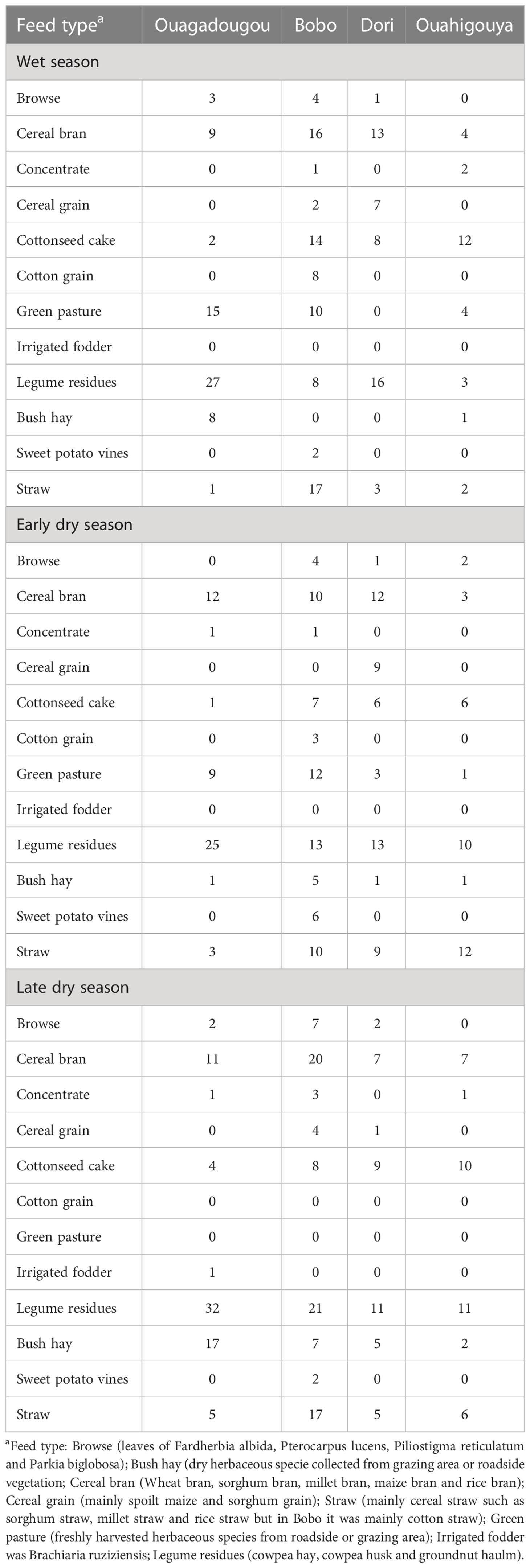
Table 1 Inventory of feeds sold at different markets in Burkina Faso according to the respondents across seasons (number of response).
The average count of feed types sold per vendor ranged from 1.5 ± 0.1 in early dry season in Dori to 3.5 ± 0.4 in late dry season in Bobo (Table 2). Generally, more diverse feeds were sold in Bobo than in other locations. Dori had a significantly lower average number of feeds sold than the other locations (Table 2). In Ouagadougou, significantly more feeds were sold per vendor in the late dry season than in the early dry season. There was no significant seasonal effect in the average number of feeds sold per vendor for all the other locations. The trend in average number of feeds sold tended to follow agro-ecological zone, that is the highest number was observed in the wettest South-Sudan zone while the lowest number was observed in the Sahel zone with the least rainfall of all the zones.
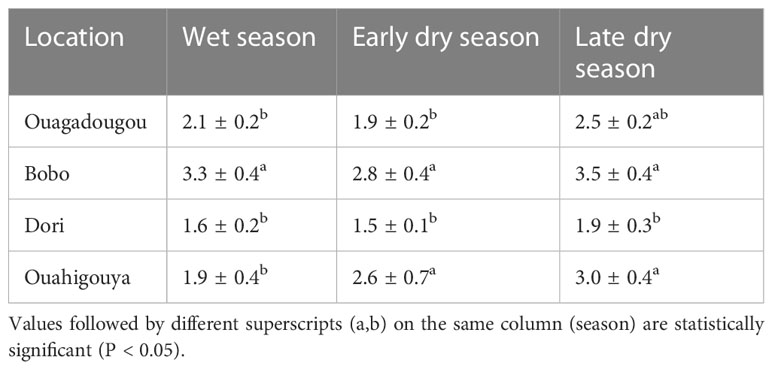
Table 2 Number (count) of feed types sold per vendor at different markets in Burkina Faso (mean ± standard error).
3.2 Provenance of feed sold
Feeds sold at different markets in our study came from diverse sources. The most common sources were crop residues from other’s farms, another feed vendor, grazing area, agro-industrial by-product shop and household food processing (Figures 2A–C). Legume residues came mainly from other’s farms or from another feed vendor. Cereal bran came mainly from household food processing, another feed vendor or an agro-industrial by-product shop. The sources of bush hay were grazing area and roadside vegetation. Cottonseed cake and concentrate for ruminants came mainly from agro-industrial by-product shops or another feed vendor. Sourcing feeds from another vendor suggests the existence of some large-scale feed vendors from where feed retailers can buy and then sell to the final consumers. The provenance of crop residues from the respondent own’s farm accounted for 25% and 14% of responses by the respondents in Dori and Ouahigouya, respectively in the early dry season, which corresponds to the period of crop harvest. The provenance of different feeds tended to vary with location and season (Figures 2A–C).
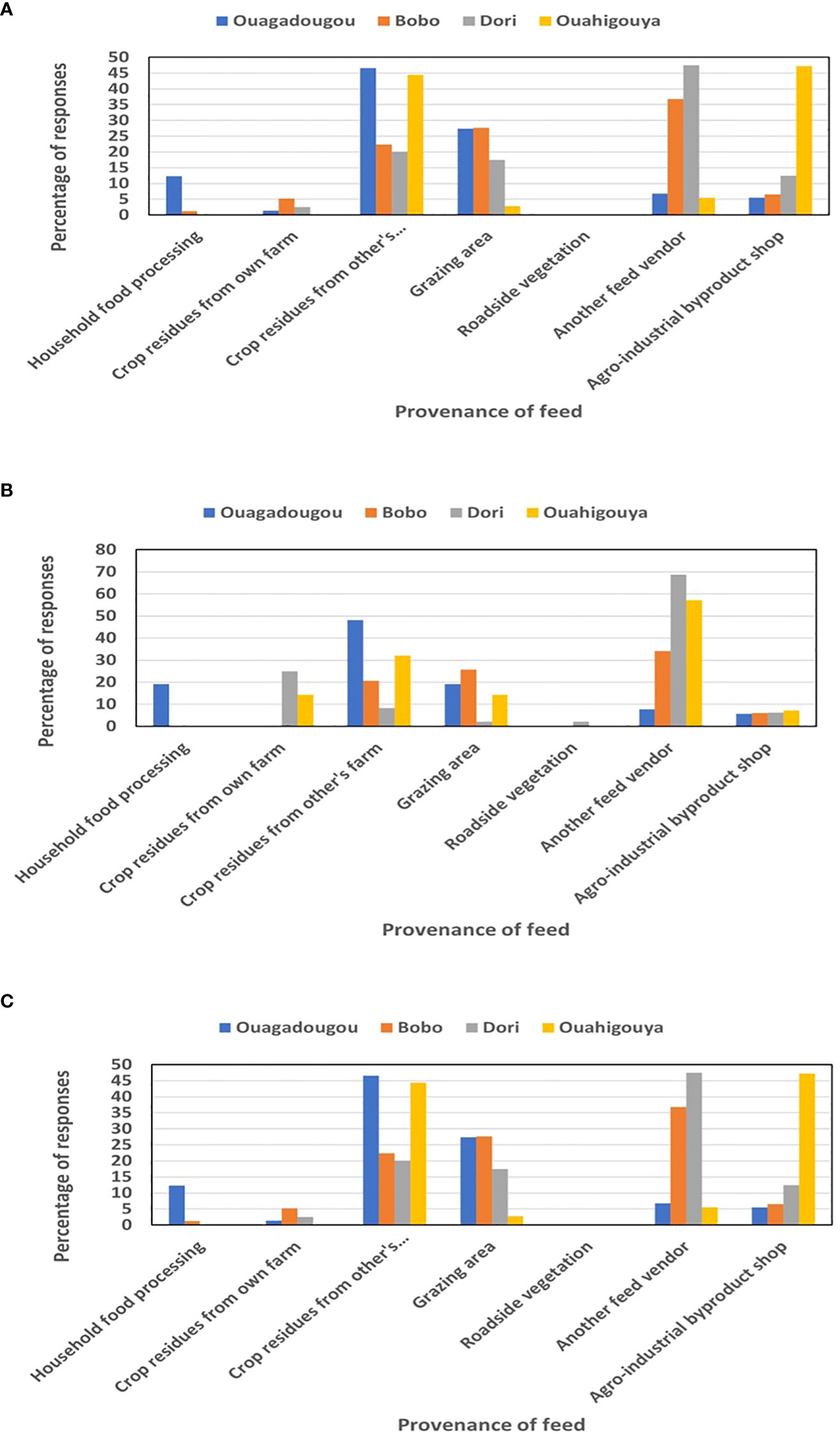
Figure 2 (A) Provenance of feeds sold at different markets in Burkina Faso in the wet season (number of responses are 75, 82, 48, and 28 for Ouagadougou, Bobo, Dori and Ouahigouya, respectively). (B) Provenance of feeds sold at different markets in Burkina Faso in the early dry season (number of responses were 52, 71, 54 and 35 for Ouagadougou, Bobo, Dori and Ouahigouya, respectively). (C) Provenance of feeds sold at different markets in Burkina Faso in the late dry season (number of responses were 73, 76, 40 and 36 for Ouagadougou, Bobo, Dori and Ouahigouya, respectively).
3.3 Reasons for sale and purchase feed
More than 80% of the feed sellers in each location reported that generation of additional income for the household was the principal reason for feed sale (Figure 3). Other reasons given for the sale of feed included urgent household need for money, difficulty in conserving crop residues and excess household feed biomass. There was no major variation in the response of the feed sellers at different seasons so we combined the data for all seasons. According to the feed buyers, the principal reasons for purchase of feed were insufficient household feed biomass, inaccessibility to grazing areas, need for supplementary feed to meet requirement for animal performance and lack of household labour to herd the animals for grazing (Figure 4). The reasons for purchase of feed varied with location. For example in Ouagadougou, the major reasons given by the respondents were inaccessibility to grazing areas, need for supplementary feed to meet animal performance, insufficient household feed biomass and lack of household labour to herd the animals for grazing in descending order (Figure 4) whereas in Dori where there was availability of herding labour in view of their pastoral tradition, the two major reasons for purchase of feed were insufficient household feed biomass and need for supplementary feed to meet animal performance. The primary occupations of feed buyers in our study sites were diverse including crop and livestock farming, livestock farming, livestock trade, salaried work, and small-scale commerce. The feed buyers in Ouagadougou and Bobo were dominated by the livestock traders (Figure 5). In Dori where the pastoralist ethnic group is dominant, almost one-third of the feed buyers were livestock farmers.
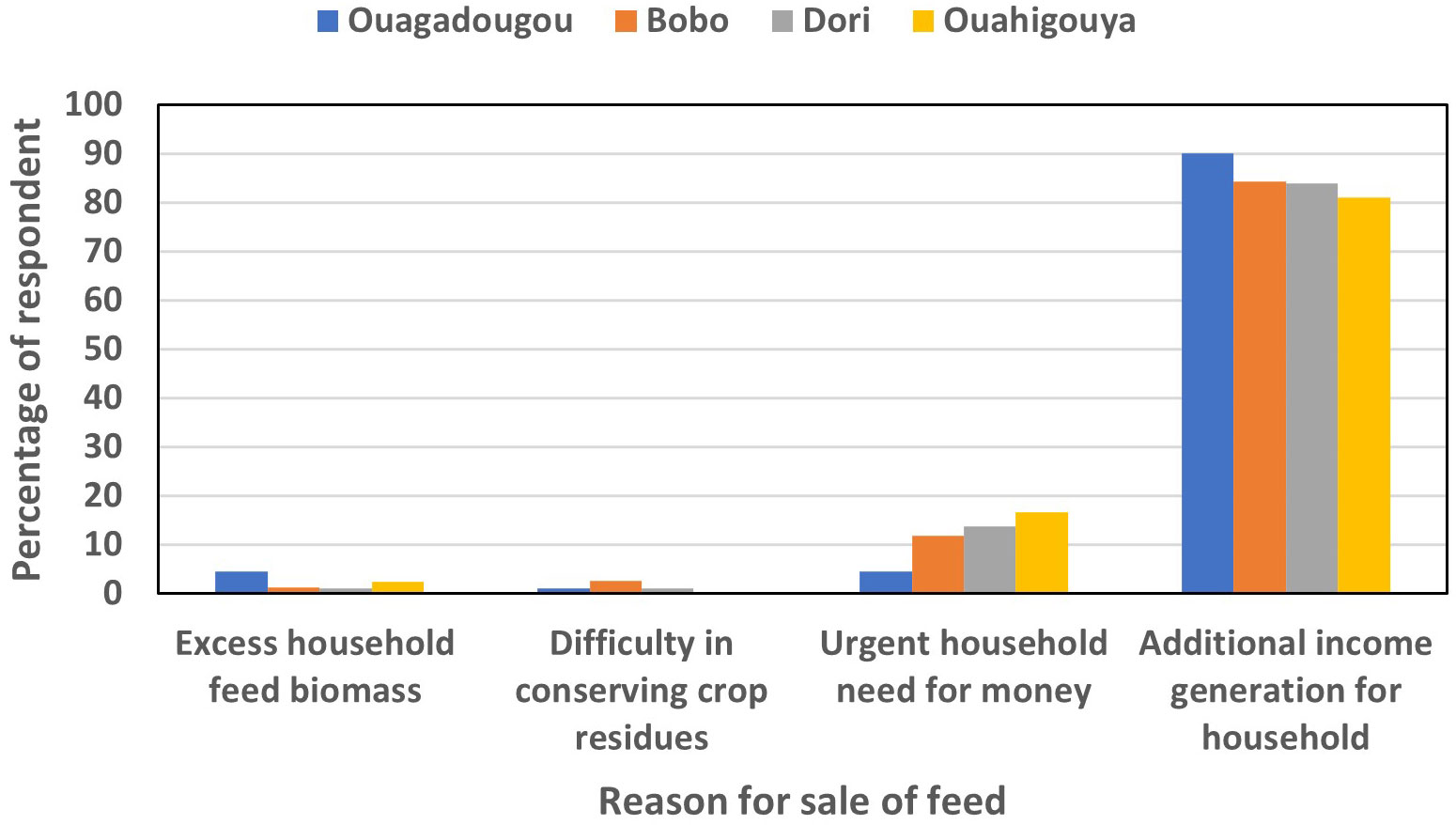
Figure 3 Reasons given by the respondents for sale of feed at different markets in Burkina Faso for all seasons (Ouagadougou n=90; Bobo n=76; Dori n=87; Ouahigouya n=42).
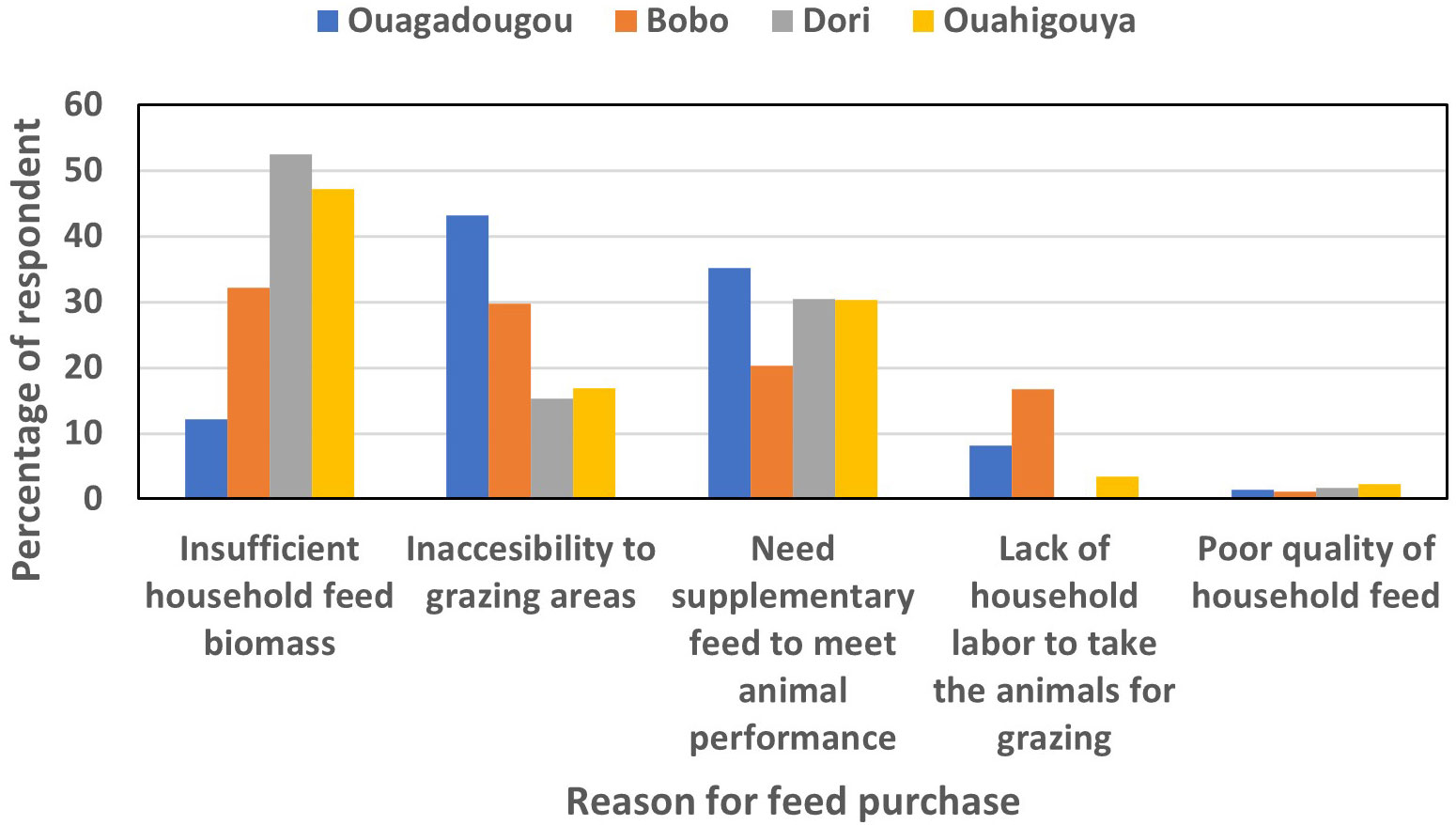
Figure 4 Reasons given by the respondents for purchase of feed at different markets in Burkina Faso for all seasons (Ouagadougou n=74; Bobo n=84; Dori n=59; Ouahigouya n=89).
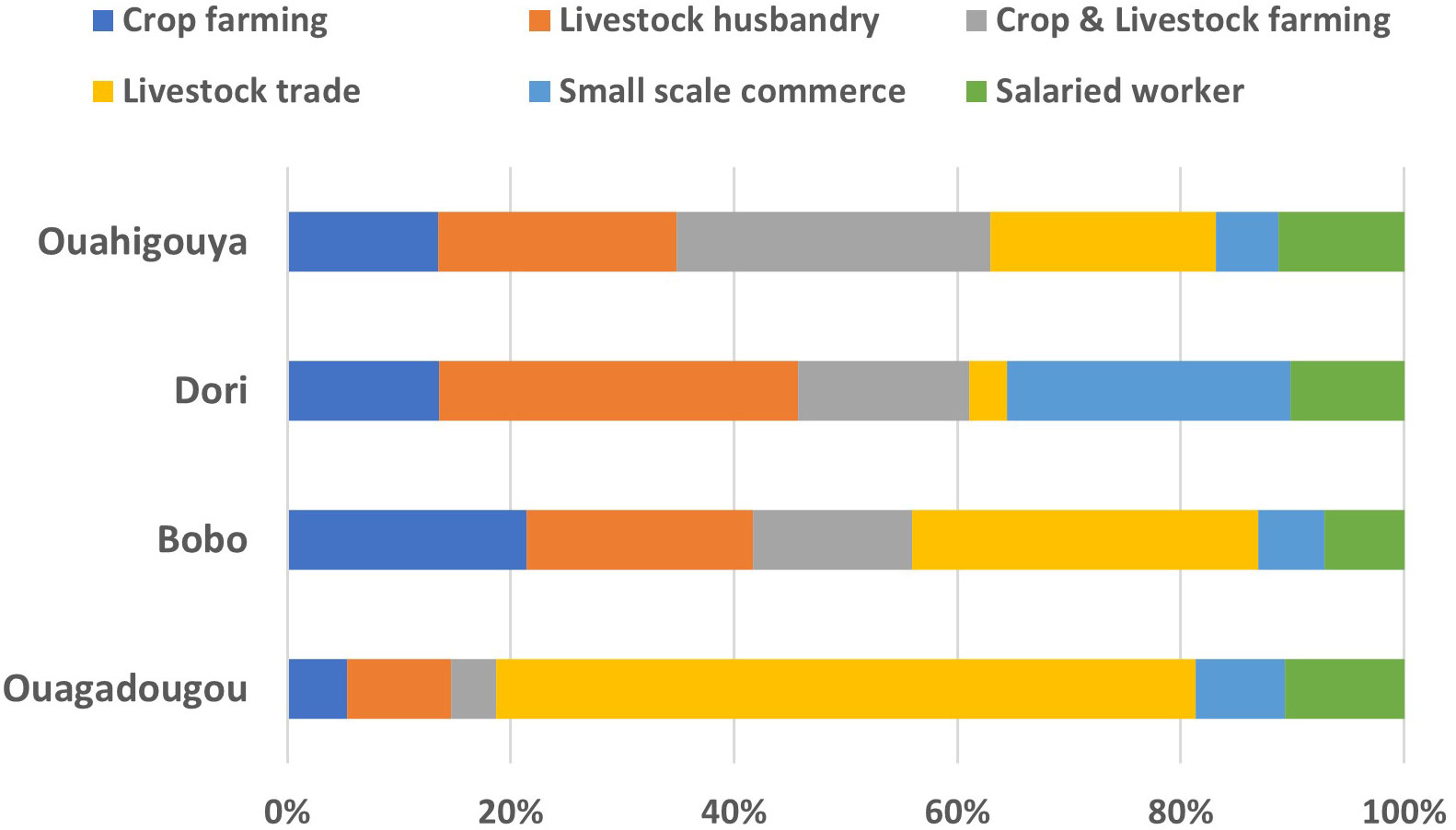
Figure 5 Primary activity of the feed buyers at different markets in Burkina Faso for all seasons (Ouagadougou n=75; Bobo n=84; Dori n=59; Ouahigouya n=89).
Buying feed every week in both dry and wet seasons was most frequent according to the respondents (Table 3), which suggests high reliance on feed purchase in the study locations irrespective of season. Regular purchase of feed across seasons is a common feature of keeping livestock in peri-urban areas of West African Sahel. In Ouahigouya, about 28% of the respondents reported buying feed a few times in the dry and wet seasons (Table 3), that is less frequent than in the other three locations.

Table 3 Frequency of buying feed by the respondents at different markets in Burkina Faso (%, with number of respondents in bracket).
3.4 Price of livestock feeds at different locations
The price of livestock feeds sold at different locations in Burkina Faso varied significantly with season, market location and feed type (Table 4). Legume residues (cowpea hay, cowpea husk and groundnut haulm) consistently had higher price than all other feed types in all locations irrespective of season. The prices of legume residues were similar in wet and late dry seasons when they are not available but significantly lower in early dry season which corresponds to crop harvest when residues are generally in abundance. Consequently, the prices of crop residues were lowest in early dry season. The price of bush hay was highest in wet season corresponding to the period of lowest availability as rain has washed away the herbaceous litters while some herbaceous litters have decomposed. The prices of cereal bran (millet, maize, sorghum, rice and wheat) were consistently lower in Ouagadougou across seasons than in other three study sites, as they (particularly millet, maize and sorghum bran) were mainly sourced from household food processing. The price of cottonseed cake tended to be higher in Bobo than in other locations despite the fact that Bobo is one of the major cotton producing areas in Burkina Faso.
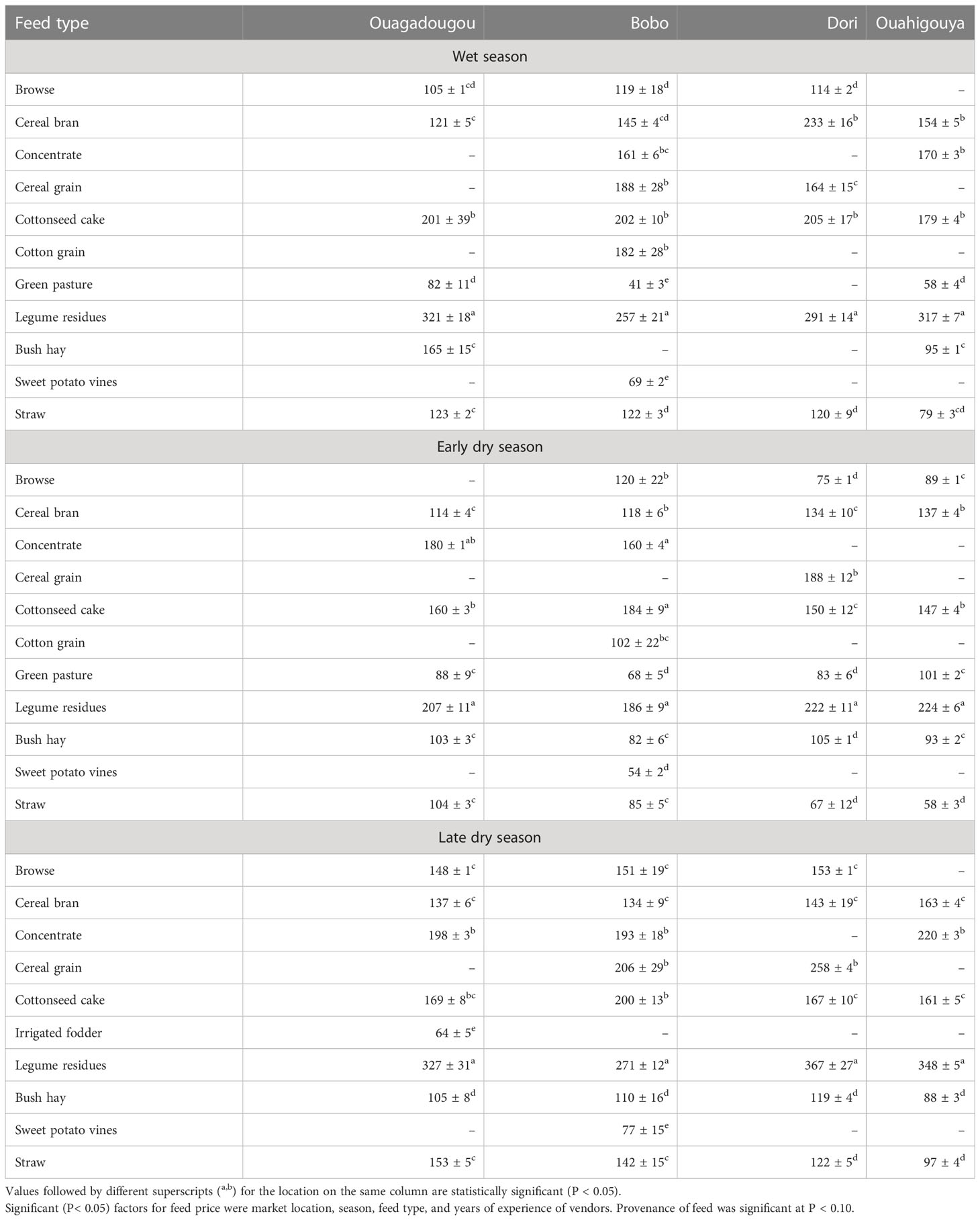
Table 4 Price (FCFA, mean ± standard error; 1 USD = 550 FCFA as at the time of this study) of common feed types at different markets in Burkina Faso across seasons.
The results of feed price at different locations showed that legume residues were sold at lowest price of 186 ± 9 FCFA/kg DM in early dry season in Ouagadougou while it was sold for highest price of 367 ± 27 FCFA/kg DM in the late dry season in Dori, suggesting the significant effect (p<0.05) of season and location on price. The results further showed the significant effect of feed type on price. For example, the prices of legume residues were significantly (p<0.05) higher than that straw across seasons (Table 4). Provenance of the feed was significant at p<0.10 suggesting that provenance might also have effect on feed price. This is expected as feeds bought from other vendors for resale such as legume residues tended to have higher price than feeds collected from grazing areas and roadside vegetation such as bush hay and green pastures. The results also showed that sex of the vendor did not have significant effect on the feed price.
3.5 Livestock feed quality across seasons
The results of crude protein content (%) and in vitro organic matter digestibility (%, IVOMD) of different feed types at the study sites across seasons are presented in Table 5. As expected, crude protein content and IVOMD varied with feed type and season. Cottonseed cake had the highest crude protein content in all locations and across seasons ranging from an average of 16.3 in Ouagadougou in the wet season to 31.9 in Ouahigouya in the early dry season (Table 5). Cereal straw (millet, maize and sorghum straw) had the lowest crude protein content of 3.5 in Ouahigouya in the wet season. IVOMD of the feeds ranged from about 43 for cotton straw in Bobo in the early dry season to 74 for browse in Dori, also in the early dry season. There were no significantly differences in crude protein content and IVOMD of each feed type across locations for a given season except for crude protein content of cottonseed cake in the wet season for Ouagadougou. In addition, the crude protein content of bush hay in early and late dry seasons in Dori was significantly lower than in other locations. Based on correlation analysis, the results also showed lack of clear relationship between price and nutritional quality (crude protein content and IVOMD; p>0.05 for a given feed except for roughage (bush hay and straw; crude protein correlation coefficient (r) = 0.356; P = 0.028; IVOMD: r = 0.286; P = 0.042) as presented in Figures 6A, B. However, there tended to be relationship between price and nutritional quality when feed types are compared. For example, in Figures 6A, B, roughage (bush hay and cereal straw) which had lowest crude protein content and IVOMD also largely had lowest price compared to other feed types namely cereal bran, legume residues and cottonseed cake.
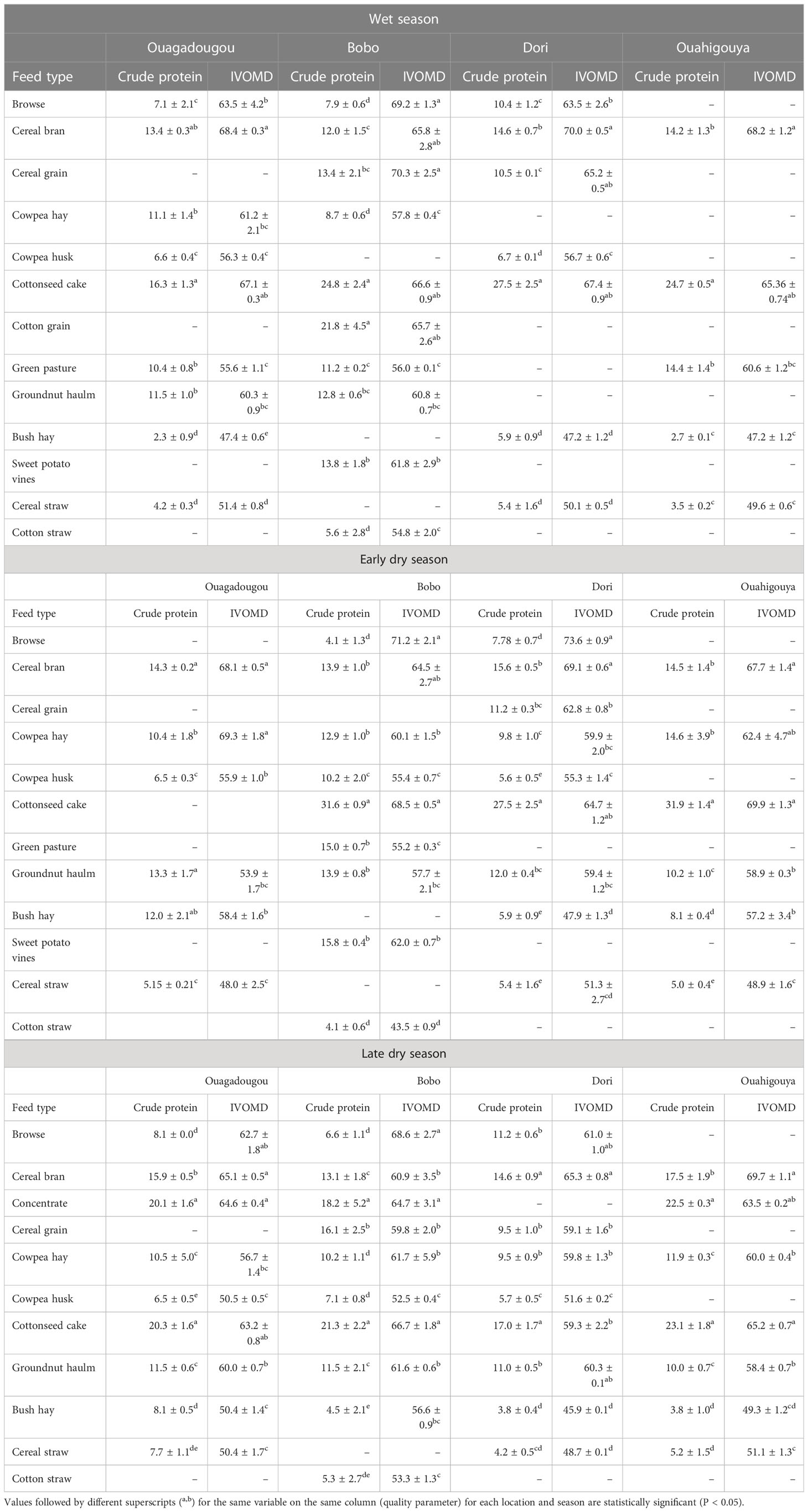
Table 5 Crude protein (%) and in vitro organic matter digestibility (%, IVOMD) of different feed types at different markets in Burkina Faso, across seasons (mean ± standard error).
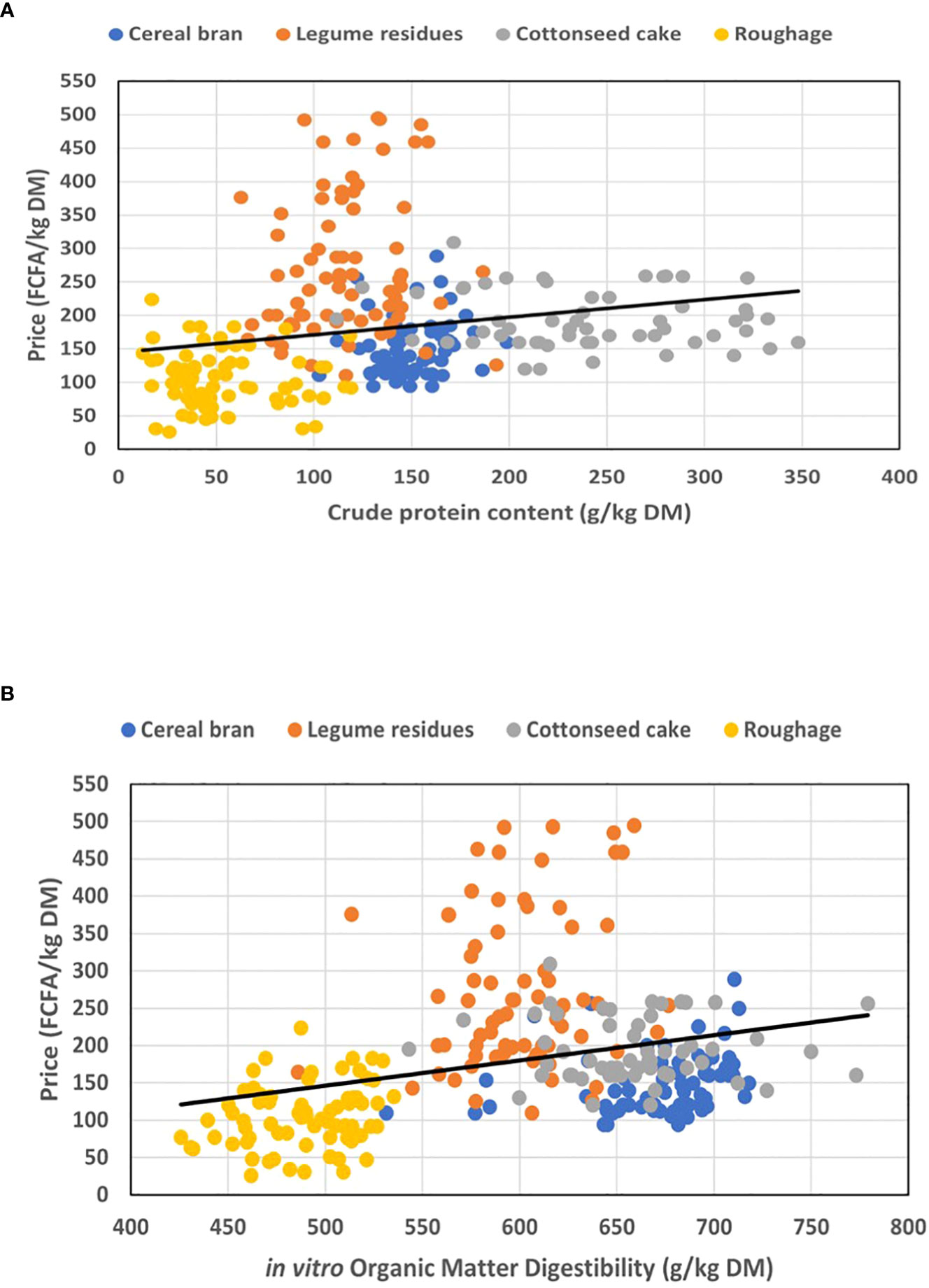
Figure 6 (A) Relationship between price and crude protein content of major feed types in the study sites for all seasons combined. (B) Relationship between price and in vitro organic matter digestibility of major feed types in the study sites for all seasons combined.
4 Discussion
The dominance of crop residues in the feed markets is consistent with previous studies (Ayantunde et al., 2014; Jarial et al., 2016) and this reaffirms the growing importance of crop residues as source of livestock feed in the Sahel (Amole et al., 2022). According to these authors, crop residues can account for up to 45% of ruminant livestock diet in arid and semi-arid zones of West Africa, which can be attributed to significant decline in grazing areas in the region due to encroachment from cropping. Legume residues, cereal bran, cottonseed cake, bush hay and straw were the most commonly sold feed types in all the locations across seasons (Amole et al., 2022). The near total absence of irrigated fodder at the feed markets in our study sites is an indication of a generally low cultivation of forage species, which may be attributed to their low adoption in West African Sahel as observed by Amole et al. (2022). The presence of cotton residues at the markets in Bobo is a reflection of the widespread cultivation of cotton in Bobo area. The trend of more diverse feeds sold in Bobo than in other locations suggests that agro-ecological zone is an important factor in feed availability as this affects floristic composition of vegetation, and the types of crops grown (Savadogo, 2000; Hiernaux et al., 2009). The declining number of feeds sold in our study sites from South-Sudan to Sahel zone is therefore expected as this reflects decline in the length of growing period.
Given that the major provenance of crop residues is crop field, removal of crop residues from the crop field may impact soil fertility as the soil is exposed to erosion (Valbuena et al., 2015). Besides, removal of the crop residues from the crop field leads to loss of organic matter that could be returned to the soil to enhance soil fertility. The increasing use of crop residues as animal feed raises the issue of trade-offs with using crop residues as soil amendment strategy. Removal of crop residues from the field for sale also undermines the previous practice of allowing the animals to graze the crop field after harvest to deposit manure on the field (Ayantunde et al., 2018), and if this persists it will result in nutrient mining from the crop field. To address the problem of nutrient mining from the crop field, Valbuena et al. (2015) suggest increasing the crop residue biomass by using improved dual purpose crop varieties, and this will allow having enough crop residues biomass for mulching after removal for animal feeding. The other possible solution is developing feed industry to boost production of concentrates and agro-industrial by-products to reduce reliance on crop residues as animal feed. To facilitate development of feed industry in Burkina Faso, the government has been supporting the establishment of small-scale feed mills around peri-urban areas in terms of provision of grants to prospective entrepreneurs, particularly young agricultural graduates. However, funding for the grants depends mainly on external donors for livestock projects, which raises the issue of sustainability. The means of transport of crop residues and bush hay from farms to the feed markets is mainly by donkey in all the study locations and the distance is normally not more than 50 km. Thus, there is no fuel cost incurred but for labor in collecting and transporting the crop residues. However, transport of agro-industrial by-products such as cottonseed cake, concentrate feeds and cereal bran is by vehicle and this implies additional transport cost. The additional transport costs partly explains the high cost of cottonseed cake, and cereal bran in Dori markets in view of long distance (about 400 km) from the sources (Bobo and Ouagadougou).
The necessity for experience in sale of feed is supported by our results showing the average year of experience of the feed sellers of about 4 to 15 years. Generally, experience is required particularly in conservation and packaging of different feed types, and in negotiation of the price with the buyers in view of the absence of quality standardization for feeds on sale. Our results on the primary activity of the feed buyers confirm the involvement of those with non-farming profession in livestock production in peri-urban areas of West African Sahel. The involvement of people with non-farming background in livestock production necessitates the purchase of feeds for the animals and this is driving the demand for livestock feeds, particularly in the peri-urban areas of the region. The domination of feed buyers in Ouagadougou and Bobo by livestock traders suggests an increasing commercialization of livestock production as observed in the peri-urban towns and cities in the Sahel by Valerio et al. (2020). As Burkina Faso is a net exporter of live animals to the coastal countries in West Africa, increasing numbers of people are engaging in the livestock trade. Livestock trade in West African Sahel is largely informal and entails buying animals (cattle, sheep and goats) from smallholder livestock farmers in rural areas and fattening of the animals in peri-urban areas before being sold to final buyers who move them to the coastal countries for sale to consumers (Valerio et al., 2020). This trend of domination of feed buyers by livestock traders is expected to continue in the peri-urban towns and cities of West African Sahel. Therefore, the development of the feed industry is necessary to meet the growing feed demand for feed in peri-urban areas and to assure stability in feed supply.
Selling feeds as a means of generation of additional income for the household, as reported by feed vendors in our study, confirms that sale of feeds can be a livelihood strategy, particularly in peri-urban areas. The main challenge to this is seasonal availability of some of the feeds, especially crop residues, which can affect income generation for the vendors. However, with necessary support to the feed vendors in accessing credit to set up shop for sale of feed concentrates and agro-industrial by-products, the feed business can be a viable venture. The results on major reasons given for the purchase of feed by the buyers in our study sites are consistent with findings from similar study in Niger by Ayantunde et al. (2022), as purchase of feed is necessary to meet household feed deficit in peri-urban livestock production. The increasing population of livestock in the peri-urban areas of the Sahel in the past three decades has exacerbated demand for feed and there is also the need for purchase of supplementary feeds as smallholder dairy production and sheep fattening are common, particularly in Ouagadougou and Bobo, in view of the increasing commercial orientation of peri-urban livestock production. The increasing dependence on feed purchase by many peri-urban livestock keepers in West African Sahel raises the question of profitability of peri-urban livestock production in the region (Ayantunde et al., 2014; Roessler et al., 2016). Two of the regions (Haut Bassins and Sahel, see Figure 1) where this study was conducted had the highest population of livestock in the country and were reported to have significant feed deficit in 2019 (Amole et al., 2022). With reported trend of climate change in West African Sahel of increased likelihood of rise in temperature and unpredictable rainfall pattern (Zougmore et al., 2016), feed availability in the study sites and the whole country will be precarious in the coming decades. This will necessitate either moving the animals to where the surplus feed is available through the continued practice of transhumance, or moving the surplus feed to where the animals are, which implies transportation of feed to feed-deficit areas and the associated increase in feed costs at the destination markets.
Our findings that legume residues (cowpea hay, cowpea husk and groundnut haulm) consistently had higher price than all other feed types in all locations irrespective of season is consistent with published results from other studies on livestock feed markets in Mali (Ayantunde et al., 2014), Niger (Jarial et al., 2016; Ayantunde et al., 2022) and in Senegal (Wane et al., 2010). The higher price of legume residues is not necessarily because of their better quality compared to other feeds but largely can be attributed to perception of the buyers, and tradition of using legume residues for small ruminant fattening in the Sahel. For example, concentrate feed, cereal bran and cottonseed cake have better nutritional quality in terms of crude protein content and in vitro organic matter digestibility but their prices are consistently lower than those of legume residues. However, it should be emphasized that legume residues do provide needed bulk without potential digestive upset that concentrates may have and have value beyond crude protein alone. The generally lower prices of crop residues in the early dry season compared to other seasons is a reflection of their abundance at this period which corresponds to the harvest period.
The variability of the nutritional quality of feeds, particularly crop residues, in terms crude protein content and in vitro organic matter digestibility with season and feed type is expected as chemical composition varies with feed materials (Amole et al., 2022). Lack of a clear trend in terms of relationship between price and nutritional quality for nearly all feeds confirms absence of quality standardization for feeds on sale at the markets in our study sites. Similar observation of lack of clear relationship between price and quality of feed has been reported for feeds sold in peri-urban areas of Bamako, Mali (Ayantunde et al., 2014) and for peri-urban areas of Maradi and Niamey in Niger (Jarial et al., 2016). This suggests that other factors besides laboratory fodder quality traits such as season, market location or agro-ecological zone, feed provenance, perceptions of farmers, traders and livestock keepers are determinants of feed price in West African Sahel. In developing feed industry in the region, the issue of quality standardization and labelling needs to be addressed by the policy makers to facilitate establishment of nutritive value-based pricing and to ensure that consumers pay for quality products. In addition, systematic support in terms of access to credit and incentives such as subsidy for the establishment of small and medium scale feed mills can facilitate the development of feed industry in the country. The government policies can also provide support for transport of feed from the feed-surplus areas of the country to the feed-deficit areas through improvement of road infrastructures and fuel subsidy. Provision of incentives for investment by big feed companies in the country can also enhance growth of feed industry in the country but this has to be managed well to avoid stifling the growth of small and medium scale feed mills.
5 Conclusion
In conclusion, to bridge the increasing feed gap for livestock, particularly in the dry season in West African Sahel, livestock keepers are increasingly turning to purchase of feeds from markets, which has contributed to the emergence of livestock feed markets in many peri-urban towns and cities in the region. Results from our surveys on livestock feed markets in Burkina Faso showed that adult male dominated feed markets in all locations and the youths (≤ 25 years) were mainly involved in sale of feed during the wet season in all the four locations. The results further showed that the determinants of feed price were season, market location, feed type, year of experience of feed vendor and to some extent the provenance of feed. As a result, there is lack of clear relationship between price and nutritional quality (crude protein content and in vitro organic matter digestibility) of feed. In developing feed industry in the region, the issue of quality standardization and labelling needs to be addressed to facilitate establishment of nutritive value-based pricing and to ensure that consumers pay for quality products.
Data availability statement
The original contributions presented in the study are included in the article. Further inquiries can be directed to the corresponding author.
Author contributions
AA designed the study, supervised data collection and cleaning, analysed the data, wrote the original draft and contributed to review of the draft. TA and AD reviewed and edited the draft manuscript. All authors contributed to the article and approved the submitted version.
Funding
This work was funded in whole or part by the United States Agency for International Development (USAID) Bureau for Food Security under Agreement # AID-OAA-L-15-00003 as part of Feed the Future Innovation Lab for Livestock Systems. Additional funding was received from Bill & Melinda Gates Foundation. Any opinions, findings, conclusions, or recommendations expressed here are those of the authors alone.
Acknowledgments
We acknowledge Elisabeth Doamba, Mohamed Hebie, Djelika Sogoba and Rachelle Same for their assistance in the collection of the data in feed markets in Ouagadougou, Dori, Ouahigouya and Bobo, respectively.
Conflict of interest
The authors declare that the research was conducted in the absence of any commercial or financial relationships that could be construed as a potential conflict of interest.
Publisher’s note
All claims expressed in this article are solely those of the authors and do not necessarily represent those of their affiliated organizations, or those of the publisher, the editors and the reviewers. Any product that may be evaluated in this article, or claim that may be made by its manufacturer, is not guaranteed or endorsed by the publisher.
References
Amole T., Ayantunde A., Balehegn M., Adesogan A. T. (2022). Livestock feed resources in the West African sahel. Agron. J. 114, 26–45. doi: 10.1002/agj2.20955
Ayantunde A. A., Adamou K., Seybou G., Moumouni O. (2022). Livestock feed markets across seasons in peri-urban areas of Niger: seller and buyer profiles, feed price and quality. Rev. d'élevage médecine vétérinaire Des. pays tropicaux 75, 47–54. doi: 10.19182/remvt.36921
Ayantunde A. A., Blummel M., Grings E., Duncan A. J. (2014). Price and quality of livestock feeds in suburban markets of West africa’s sahel: case study from Bamako, Mali. Rev. d'élevage médecine vétérinaire Des. pays tropicaux 67, 13–21.
Ayantunde A. A., de Leeuw J., Turner M. D., Said M. (2011). Challenges of assessing the sustainability of (agro)pastoral systems. Livestock Sci. 139, 30–43. doi: 10.1016/j.livsci.2011.03.019
Ayantunde A., Hiernaux P., Fernandez-Rivera S., Sangare M. (2018). “Nutrient management in livestock systems in West Africa sahel with emphasis on feed and grazing management,” in Improving the profitability, sustainability and efficiency of nutrients through site specific fertilizer recommendations in West Africa agro-ecosystems. Eds. Eds. Bationo A., Ngaradoum D., Youl S., Lompo F., Fening J. (Cham, UK: Springer), 11–23.
Ayantunde A. A., Oluwatosin B. O., Yameogo V., Wijk M. (2020). Perceived benefits, constraints and determinants of sustainable intensification of mixed crop and livestock systems in the sahelian zone of Burkina Faso. Int. J. Agric. Sustainability 18, 84–98. doi: 10.1080/14735903.2019.1698494
Blummel M., Rao O. P. P. (2006). Economic value of sorghum stover traded as fodder for urban and peri-urban dairy production in Hyderabad, India. Int. Sorghum Millets Newslett. 47, 97–101.
Hiernaux P. H. Y., Ayantunde A., Kalilou A., Mougin E., Gerard B., Baup F., et al. (2009). Trends in productivity of crops, fallow and rangelands in southwest Niger: impact of land use, management and variable rainfall. J. Hydrology 375, 65–77. doi: 10.1016/j.jhydrol.2009.01.032
Jarial S., Blummel M., Soumana I., Ravi D., Issa S., Whitbread A., et al. (2016). “Legume residue trade in crop-livestock markets of Niger,” in Pan-African Grain and World Cowpea Conference, Livingstone, Zambia, February 28th to March 4th 2016. International Institute for Tropical Agriculture, Ibadan, Nigeria.
Ouedraogo K., Zaré A., Korbéogo G., Ouedraogo O., Linstädter A. (2021). Resilience strategies of West African pastoralists in response to scarce forage resources. Pastoralism: Research Policy Pract. 11 (16). doi: 10.1186/s13570-021-00210-8
Rocateli A., Zhang H. (2017). Forage quality interpretations (Stillwater, Oklahoma, USA: Soil, Water & Forage Analytical Laboratory, Oklahoma State University). Available at: https://extension.okstate.edu/fact-sheets/forage-quality-interpretations.html.
Roessler R., Mpouam S. E., Muchemwa T., Schlecht E. (2016). Emerging development pathways of urban livestock production in rapidly growing West Africa cities. Sustainability 8, 1199. doi: 10.3390/su8111199
Savadogo M. (2000). Crop residue management in relation to sustainable land use: a case study in Burkina Faso (The Netherlands: University of Wageningen), 159.
Savadogo M., Zemmelink G., Van Keulen H., Nianogo A. J. (1999). Contribution of crop residues to ruminant feeding in different agroecological zones of Burkina Faso. Rev. d'élevage médecine vétérinaire Des. pays tropicaux 52, 255–262.
Statistical Analysis System (SAS) institute (1987). SAS/STAT for personal computers (Cary, NC, USA: SAS Institute).
Valbuena D., Homann-Kee Tui S., Erenstein O., Teufel N., Duncan A., Abdoulaye T., et al. (2015). Identifying determinants, pressures and trade-offs of crop residue use in mixed smallholder farms in Sub-Saharan Africa and south Asia. Agric. Syst. 134, 107–118. doi: 10.1016/j.agsy.2014.05.013
Valerio V. C., Walther O. J., Eilittä M., Cissé B., Muneepeerakul R., Kiker G. A. (2020). Network analysis of regional livestock trade in West Africa. PloS One 15, e0232681. doi: 10.1371/journal.pone.0232681
Wane A., Touré I., Ancey V. (2010). Pastoralisme et recours aux marchés – cas du sahel sénégalais (Ferlo). Cahiers Agricultures 19, 1–7.
Zampaligré N. (2012). The role of ligneous vegetation for livestock nutrition in the sub sahelian and sudanian zones of West Africa: potential effects of climate change (Germany: PhD thesis, University of Kassel), 100.
Zougmore R., Partey S., Ouédraogo M., Omitoyin B., Thomas T., Ayantunde A., et al. (2016). Toward climate−smart agriculture in West Africa: a review of climate change impacts, adaptation strategies and policy developments for the livestock, fishery and crop production sectors. Agric. Food Secur. 5, 26. doi: 10.1186/s40066-016-0075-3
Keywords: livestock, feed resources, feed markets, nutritive value, Sahel
Citation: Ayantunde AA, Amole T and Duncan AJ (2023) Livestock feed markets across agro-ecological zones of Burkina Faso: feed provenance, price and quality. Front. Anim. Sci. 4:1122416. doi: 10.3389/fanim.2023.1122416
Received: 12 December 2022; Accepted: 14 April 2023;
Published: 02 May 2023.
Edited by:
Geoffrey E. Dahl, University of Florida, United StatesReviewed by:
Andres Alfredo Pech-Cervantes, Fort Valley State University, United StatesElaine Grings, Cheyenne, WY, United States
Copyright © 2023 Ayantunde, Amole and Duncan. This is an open-access article distributed under the terms of the Creative Commons Attribution License (CC BY). The use, distribution or reproduction in other forums is permitted, provided the original author(s) and the copyright owner(s) are credited and that the original publication in this journal is cited, in accordance with accepted academic practice. No use, distribution or reproduction is permitted which does not comply with these terms.
*Correspondence: Tunde Amole, dC5hbW9sZUBjZ2lhci5vcmc=
†Present address: Wageningen Livestock Research, Wageningen University and Research, Wageningen, Netherlands
 Augustine A. Ayantunde1†
Augustine A. Ayantunde1† Tunde Amole
Tunde Amole Alan J. Duncan
Alan J. Duncan